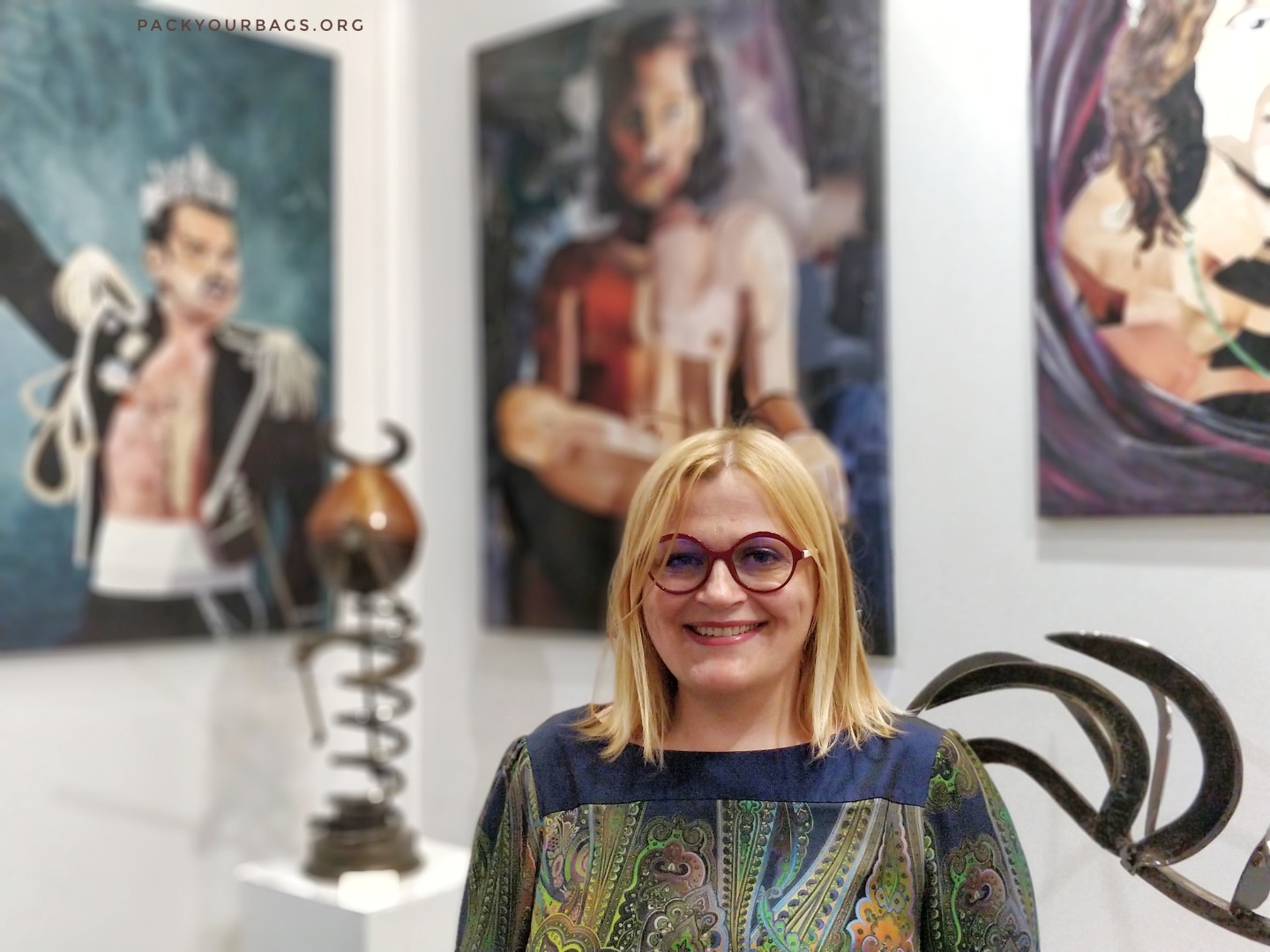An Interview with artist Margot Gunta Delhomme
People travel for many different reasons. This past weekend, I traveled to Paris for the sole purpose of meeting with one of my favourite artists, Margot Gunta Delhomme. Margot was at Art Shopping Paris (May 25-27, 2018) expo at the Carrousel du Louvre presenting her work.
Not only was I able to admire her unique and beautiful pieces of art but I also had the privilege to interview Margot who grew up in Latvia. I met this artist a few years ago in Provence. She was just at the beginning of her career. What drew me to her collage portraits, was her use of vivid colour and how alive with emotion they were. Aside from her lovely work, I also admire her very real talent and her drive to work and create.

Q: When did you know you wanted to become an artist?
Becoming an artist was my childhood dream … eventually forgotten, instead I focused on beauty and professional make up, body painting. I even got a few prizes in international contests. Recently, once I turned 40 I returned to my childhood dream. It was now or never. I went back to school to study graphic design. At the beginning, my focus was on artistic technique.

Q: Why did you choose collage as your preferred expression in art?
During my first year as an artist, I tried a lot of techniques including my first collage portrait using mosaic technique from old ripped magazines. Even though it was my very first time, I felt incredibly comfortable with the exercise … As if I had had always known how to do it, without being aware of it. This first portrait of my son, evoked a lot of powerful emotions for me. One day, my mother-in-law who is an artist herself, came over for dinner and when she saw this piece, she also found it very moving. She was getting ready for an exhibition of her sculptures made from old metal tools, and she suggested I join her. I was completely unprepared for that. I had a month to create six more portraits of my son.

Q: Describe your work process for a collage piece?
Typically, for a portrait, I first draw on paper or canvas, (I prefer canvas). Then I rip pages from magazines and sort them by colour. I have a lot of magazines in my workshop and it is quite messy. I start the process with the background, sometimes I paint it, sometimes I use collage. The very first thing I do on a portrait is the eyes, as it does give life to the portrait instantly. As a result, my communication with the artwork begins at this moment. I then continue with the face, and finish with the hair (if any).
Q: You mostly create portraits. What fascinates you so about the human face?
The reason for my love of portraits is simple : I love people and faces, my challenge is to communicate emotions. And that’s why eyes are key.

Q: Which artists inspire you?
In my childhood, the artist I felt the strongest connection to, was Auseklis Baukšķenieks (1910–2007), a Latvian painter. I had a book with photos of his art, which I loved to look at. This artist’s works have a unique style, a combination of naïve art and surrealism.
My inspiration also comes from Tetsugorō Yorozu, One of the early 20th-century pioneers of modern Japanese painting. He himself was influenced both by Fauvism and Cubism.
And Picasso, of course. When I was studying in Paris, I often visited the Picasso Museum. I learned to understand his art. One Picasso quote is engraved in my memory forever: “Every child is an artist. The problem is to remain an artist once we grow up.” I’m still trying to remain an artist despite being an adult.
I also want to mention René Magritte with his surreal works. I feel very close to his universe.

Q: What projects are you working on right now?
My next two projects are:
(1) Revisiting major art pieces, I just did The Mona Lisa, The Venus by Botticelli and The Orphan Girl by Delacroix. By doing so I learn from major artists, and it is quite challenging. It is difficult to make small details in a collage.
I also do collages of famous singers: Freddy Mercury, Jim Morrison, Amy Winehouse (in progress) and so on. I want to have a collection of all my favourites singers.
(2) And my latest project is a big format canvas that will be exhibited in the streets of Carpentras in the south of France in July and August for the Papillons Festival.

Q: What is the most indispensable item in your studio?
The most important things for me when I work are a quiet room where I can be alone, listening to the music of the singer I am doing the portrait of (if applicable), scissors, glue … and a cup of coffee on hand.

Q: If you could own any piece of art in the world, what would it be and why?
That would be a Matisse portrait (Henri Matisse, Large Odalisque in Striped Pantaloons ”1925, lithograph) of a nude woman which I would love to have in my bedroom. Reaching this level of artistic expression is my ultimate goal. It was in 1906 when Matisse discovered the process of lithography. The lithographic pencil reflects the softness of the different materials: velvet, silk and skin.
Q: This weekend, you are showing your art at an expo only a few steps away from the Louvre. How exciting is that?
I am of course very excited to exhibit in such a prestigious place. Imagine my version of The Mona Lisa will be displayed a few meters away from the original. Being surrounded by the works of major artist does make it very special.

Q: What is your advice for artists who are just starting out?
My advice would be to follow your intuition and not to listen to destructive and negative critiques. Try, explore, experiment, play, be curious.
To see more of this artist’s work, follow Margot Gunta Delhomme on any of these:
Merci!
Pin It!

















8 comments
What an interesting post, thank-you for sharing. I love that you write bilingually as well. Such a great resource.
Thank you, Helen! This was my first foray into a bilingual post. I had help from a native French speaker to correct my errors. 🙂
This looks like it was so much fun! I’m definitely going to check her out on IG now. 🙂
It was amazing! You will love her art.
I really enjoyed this insight into a new artist for me. I love the idea of collage art ~ some lovely ones shown in this post 👌😍
Thank you, Helen. I love collage art as well. What I love about this artist the most is the vivid use of colour.
How cool that you were able to go and meet her!
Thanks, Emma! Yes, it was quite a lovely adventure. 🙂